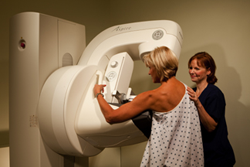
November 28, 2011 – A year after clinical trials began in Japan, Fujifilm Medical Systems U.S.A. today announced at the Radiological Society of North America (RSNA) 2011 Annual Meeting that clinical trials for their 3-D digital mammography technology are about to commence in the United States. The medical imaging and informatics company is currently installing 3-D mammography systems at renowned medical centers across the country with plans to begin trials as early as December 2011.
“When it comes to the early detection of breast cancer, radiologists will benefit from powerful 3-D technology to elevate their diagnostic confidence, using an average glandular dose that is equivalent to 2-D full field digital mammography (FFDM), increase their workflow, and give their patients improved outcomes,” said David Hotchkiss, director of Modality Solutions Marketing at Fujifilm. “After thorough evaluation of needs of the patients and clinicians, we believe that, when approved by the FDA, Fujifilm’s 3-D digital mammography has the potential to become the standard of care. We remain committed to improving our breast screening technologies, and we are confident that this will be the screening technology of choice.”
Currently commercially available for sale and in use in Europe, Fujifilm’s 3-D digital mammography is an innovative breast screening technology that presents the images to radiologists in an in-depth, three-dimensional view. Pairs of stereo images of the breast are acquired and then viewed by combining a 3-D review workstation and dedicated glasses specifically designed to present 3-D breast images. Because 3-D digital mammography uses the similar clinical workflow as traditional FFDM, and because it presents the stereo images in a standard mammographic view of the breast (e.g., LCC, RCC, LMLO or RMLO) that is familiar for radiologists, it has the potential to increase throughput and diagnostic confidence. The new 3-D system will be especially powerful when viewing overlapping tissue, especially in dense breasts, and will enable radiologists to better visualize abnormalities. This assertion is supported by a previous study of 3-D stereo digital mammography at Emory University that demonstrated a 23 percent increase in sensitivity, and a 46 percent reduction in patient call backs.
According to Satoshi Arakawa, vice president of the Medical Systems Division at Fujifilm Europe, “European clinicians are expressing increased enthusiastic interest in the 3-D system. Initial reports of ongoing studies in Germany indicate that the low-dose 3-D FFDM system has yielded statistically significant reduction in recall rates.”
Images will be acquired with the AspireHD Plus FFDM system upgraded with 3-D capability that will combine the use of innovative Direct Optical Switching (DOS) detector technology and Fujifilm’s legacy 50-micron resolution to produce the image quality and detailed visualization that is particularly critical for interpreting mammography studies.
For more information: www.fujimed.com


 July 29, 2024
July 29, 2024 








